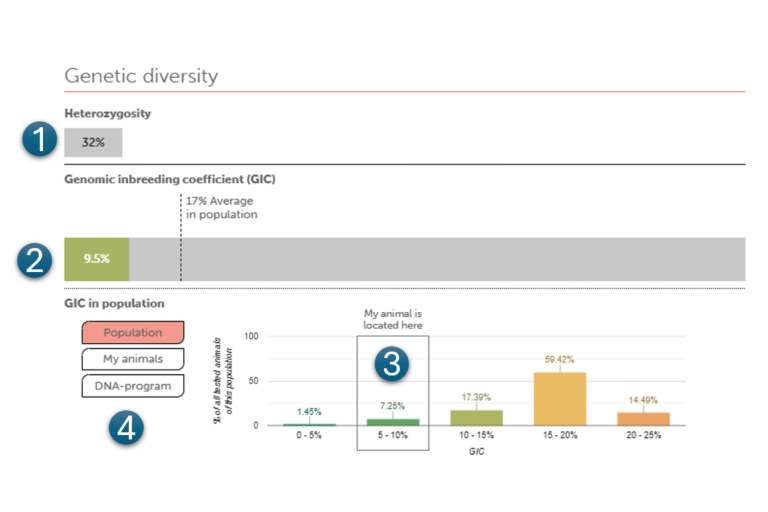Genomic inbreeding coefficient
Genomic inbreeding coefficient
Genomic inbreeding coefficient (GIC) measures the proportion of the individual's DNA that has been inherited from recent common ancestors, and thus gives a measure of the percent of the individual's genome that is inbred.
Bitte beachten Sie: Je nach Auflösung des verwendeten SNP-Array resultieren unterschiedliche GIK - Werte.
Hat der verwendete Chip eine geringe Auflösung, sind die GIK-Werte niedriger. Der dann vermeintlich bessere Wert zeigt nicht eine bessere Inzuchtlage an, sondern beruht jedoch lediglich auf dem "Übersehen" von Inzuchtbereichen geringer Ausdehnung.
Die Wahl des richtigen Arrays (SNP-Chips) richtet sich nach der untersuchten Tierart, der in der Zuchtpraxis bisher angewandten Inzucht sowie der Breite der vorhandenen Zuchtbasis.
Traditionally, the inbreeding coefficient was estimated using pedigree records. This method had significant limitations, primarily neglecting inbreeding events that occurred before the evaluated generations.
At Generatio, we determine the actual inbreeding status of an animal using genomic information obtained from SNP-array analysis. This advanced approach assesses the variability of an animal's genome across its species, indicating the level of inbreeding, including background inbreeding from domestication and breed development. This measure is known as the genomic inbreeding coefficient (GIC).
By using genomic data, it becomes possible to determine the genetic inbreeding status of an animal without precise knowledge of the relatedness of its parents or other ancestors. This method provides a more accurate and comprehensive understanding of an animal's genetic diversity and inbreeding level.
Bewertung
Bei der Bewertung müssen die jeweiligen Hintergründe des untersuchten Tieres berücksichtigt werden:
- Tiere, die einer Rasse angehören, die durch Inzucht etabliert wurde und in der über viele Generationen hinweg Inzucht praktiziert wurde. In solchen Population mit sehr hohen mittleren Inzuchtwerten, können Einzeltiere hohe GIK-Werte (>40%) aufweisen und trotzdem gesund sein. Hintergrund ist das während der Rasseetablierung erfolgte ‘purging’ (Link zu Wikipediabeitrag)
- Bei Tieren aus Populationen mit geringer allgemeiner Inzucht (< 10 %) wären GIK-Werte über 25% ein deutliches Zeichen einer sehr engen Verwandtschaft der Elterntiere. Bei solchen Population führen ‘Inzestpaarungen’ immer zu einem erhöhten Risiko, dass seltene rezessive Defektallele reinerbig zusammenkommen.
Generell bedeuten hohe individuelle GIK-Werte keine Zuchteinschränkung. Allerdings ist es wichtig, für diese Tiere einen Zuchtpartner zu finden, mit dem die jeweils gegebenen ingezüchteten Bereiche im Genom ausgeglichen werden können. Unsere Tools zur Paarungsplanung helfen hier sowohl bei Bewertungen als Einzelpaar, als auch bei der Anfertigung kompletter Ranglisten einer Zuchtpopulation.
Beispiel
GIK und HE in der Online-Tierakte
- Heterozygosity is shown as a percentage.
- The Genomic Inbreeding Coefficient is also shown as a percentage within a colored bar. The color and length of the bar provide information about the degree of inbreeding. A green bar indicates a low value, while a red bar indicates a higher value. A dashed line indicates the current mean inbreeding value of the animals examined in the population in question.
- The gray frame in this diagram shows the position of the animal examined in comparison to other animals in the population. In this example, the animal has a value of 4.9%. This places it in the first bar, which represents animals with similar values (0-5%). The colored number above the bar indicates that 79.75% of all animals in the population also have values between 0% and 5%. The adjacent bar, which shows values from 5-10%, contains 8.86% of all animals in the available population data.
- The options on the left allow you to display the animal under investigation in comparison to different groupings, provided that data is available.

